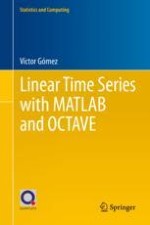2019 | OriginalPaper | Buchkapitel
2. Stationarity, VARMA, and ARIMA Models
verfasst von : Víctor Gómez
Erschienen in: Linear Time Series with MATLAB and OCTAVE
Aktivieren Sie unsere intelligente Suche, um passende Fachinhalte oder Patente zu finden.
Wählen Sie Textabschnitte aus um mit Künstlicher Intelligenz passenden Patente zu finden. powered by
Markieren Sie Textabschnitte, um KI-gestützt weitere passende Inhalte zu finden. powered by
